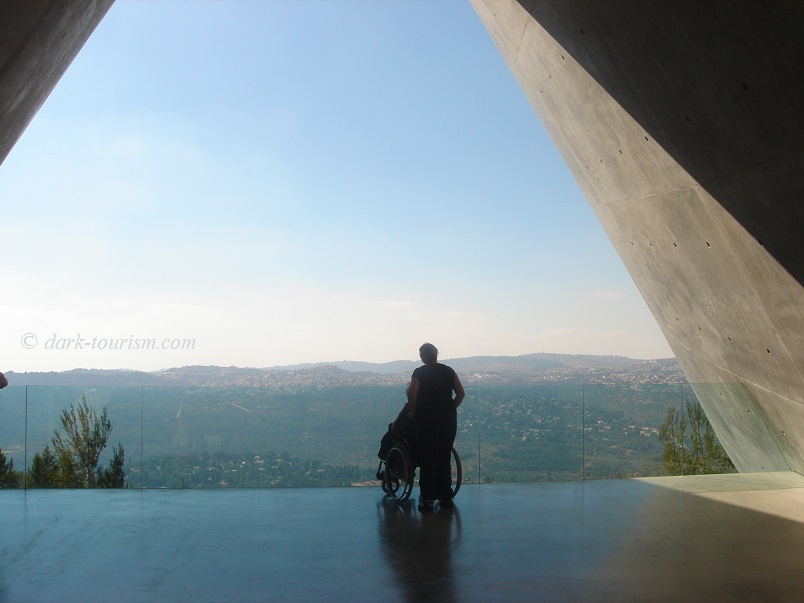The world’s news is full of the horrible events in Israel and the Gaza Strip that started with the surprise attacks by Hamas, first from last Saturday with a barrage of missiles like never before, then also the breaching of the border fence and incursions into Israeli territory by militant Hamas fighters. The massacres and abductions they committed are stomach-turning – as was the footage of people celebrating these deeds in some pockets of the (Islamic) world. Yet the brutality of the collective-punishment counter-attacks by Israel is hardly less difficult to take in, with the civilian population of Gaza suffering yet more than they already had (and what that can mean on a personal level is touchingly described in this article – external link, opens in a new tab). It’s all just sheer horror. Hopefully it won’t escalate further and get completely out of control in the wider Middle East.
Just two and a half weeks ago I mused in this previous Blog post that the signal sent by Azerbaijan’s “victory” in Artsakh/Nagorno-Karabakh by military force is a worrying one … namely that such military aggression pays off. It could be tempting to say now that Hamas didn’t need long to take the hint. But of course I know that it has to be assumed that the attacks by Hamas must have been many months in the planning and most likely have very little to do with Artsakh, Armenia and Azerbaijan.
In that previous post I also predicted that the ethnic cleansing of the Armenians of Artsakh/Nagorno-Karabakh would probably be complete before too long. This now seems to be the case indeed, with virtually the entire ethnic Armenian population having fled to Armenia. Azerbaijani propaganda claims they left “voluntarily”; but that’s callously ignoring the actual reason for this exodus – very real and justified fears of severe reprisals, repression and atrocities … it wouldn’t be the first time in this deeply troubled region. (By the way, this article – external link, opens in a new tab – is a rare exception of an Azerbaijani acknowledging what his country is doing … and it comes with a dark twist of its own at the end; do take a look).
Sadly, the age-old arch-enmities between Armenia and Azerbaijan (and Turkey!) seem to be impossible to overcome – very much like those in the Middle East, really.
And with that we come back to Israel. Just like recent developments in Artsakh inspired me to take a nostalgic look back to when I travelled to that region, I can now do the same for Israel. I visited the country in August 2006, at a time when Israel was having “troubles in the north”, as the euphemism back then was when referring to the border war with Lebanon at the time, but it was nowhere on the scale of the horrors now.
The reason I went to Israel was completely unrelated to those “troubles”, though (I do NOT engage in war tourism!). My wife and I had been invited to attend the Jewish wedding of an ex-colleague and friend of my wife’s. Many of those invited from outside Israel had cancelled their trips in the light of the ongoing conflict in the north of the country. But we decided not to let her down as well, and so we went (despite people at home urging us not to). And I’m so glad we did. We gained a deeper insight into the country and its psyche that I still value very much to the present day.
As there were few tourists around at the time (80% had cancelled) we were also able to experience the sights and sheer weight of history in places like Jerusalem without the distraction of mass tourism, and in the company of Jewish travellers from various countries and walks of life (from a British ex-BBC correspondent to an American 18-year-old boot-camp GI-in-the-making who was fearful of his Polish Jewish grandmother).
We started in Tel Aviv, for practical reasons, having flown into its international airport (where security was extra tight and the grilling by border security officers intense and intimidating). And before the wedding we had a few days to explore the city and do a couple of day excursions.
The following is mainly a photo essay giving some impressions, with a focus on dark aspects, of course (please excuse the poor quality of many of these photos – they were taken with an old digital camera which, compared to today’s standards, wasn’t very capable).
First off here’s a photo from Tel Aviv:
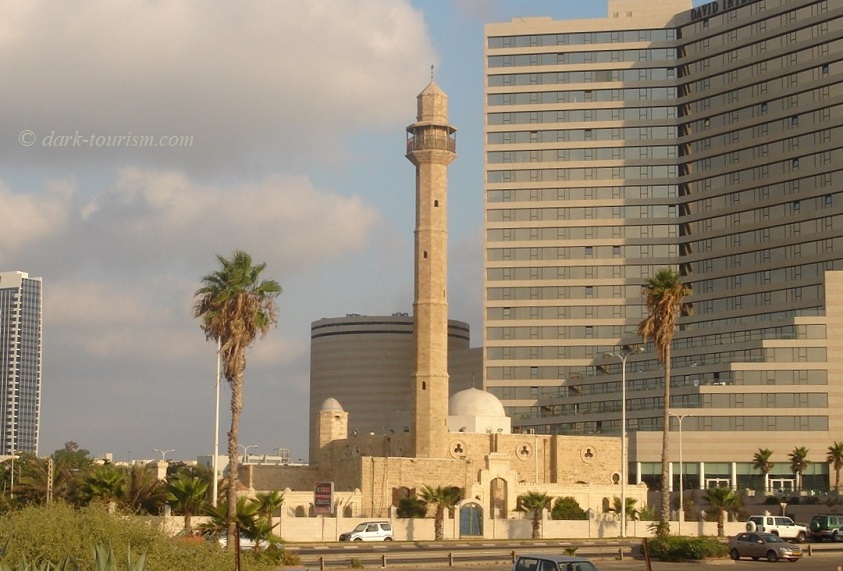
That photo suggests a harmony between the local cultures that is deceptive, of course. As we see now there’s anything but harmony … While that image is looking inland from the seaside, here’s a photo of the seafront looking south along the coast towards the ancient city of Jaffa, now part of modern Tel Aviv, and a district with a high Arab proportion in its population:
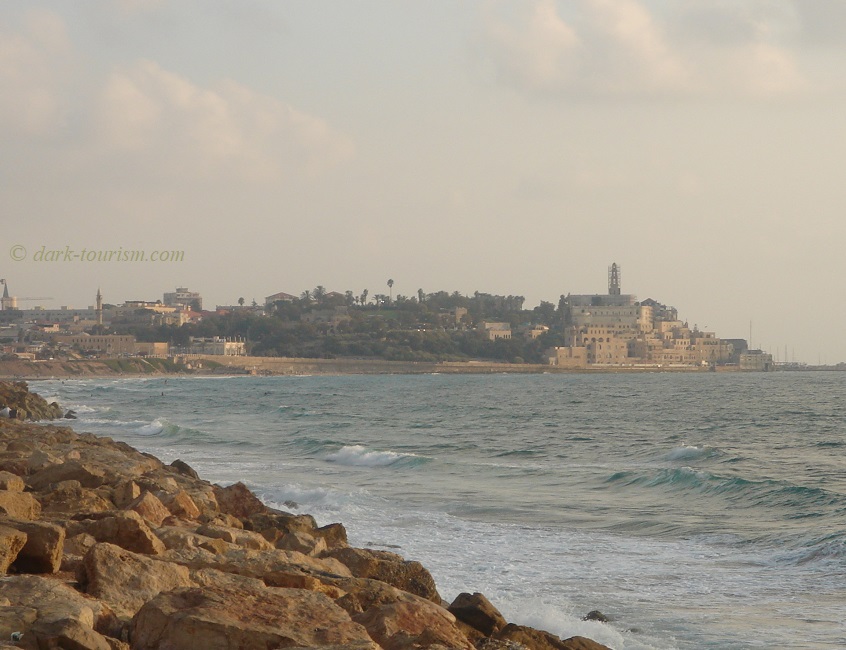
Looking out over the sea there were occasionally signs of military activity, such as navy boats patrolling the coast, fighter jets flying past or, as in this photo, military helicopters:
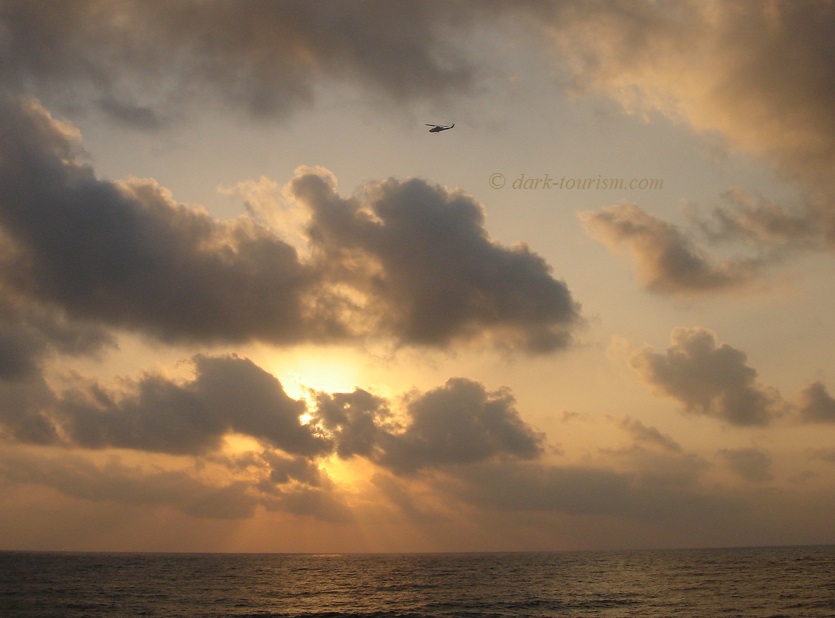
In the city, security was pretty tight too. You couldn’t enter any shopping mall or so without an armed guard thoroughly checking any bags you might have on you. While that was a little inconvenient, it did however provide a certain sense of safety. I also noticed that places like bus stops often had a security post nearby – as seen in this next photo:
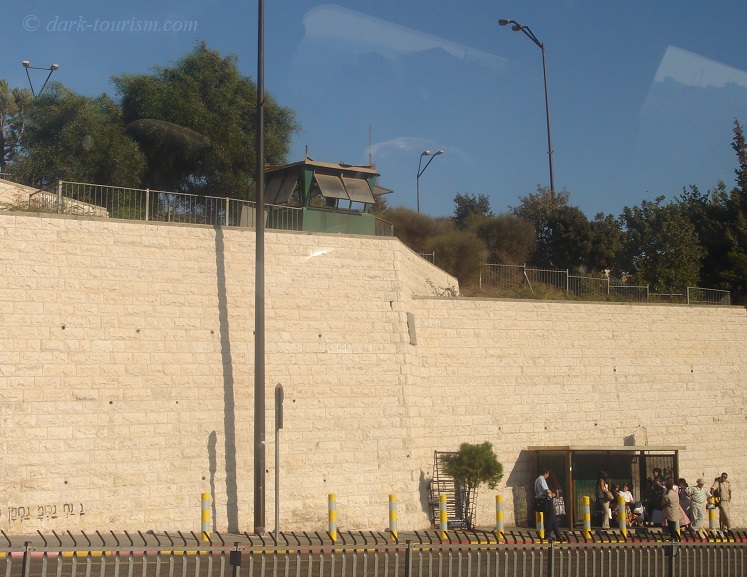
Other reminders of the security situation at the time were things like restaurants promoting wine from the Golan Heights “because of the problems we are having in the north” (that euphemism again!).
We did two organized excursions, the first one to Masada and the Dead Sea (see below). As tourism was minimal, due to those “problems”, there weren’t many other takers, so we were driven by minibus rather than the usual full-size coach you’d normally get. We picked up a couple of participants at the bus station … and here we witnessed soldiers, including young women, machine gun flung over one shoulder, boarding buses to take them to the front. That’s when the reality of the ongoing conflict hit us most. It was also a moment when we felt like we might actually be a target, here at a big busy bus station, with troop movements all around us … So we were glad when we finally pulled out of the bus station.
The route to the Dead Sea partly went through West Bank Palestinian territory. At a petrol station where we made a short stop was another military security presence in the form of that armed jeep on the left in this next photo:
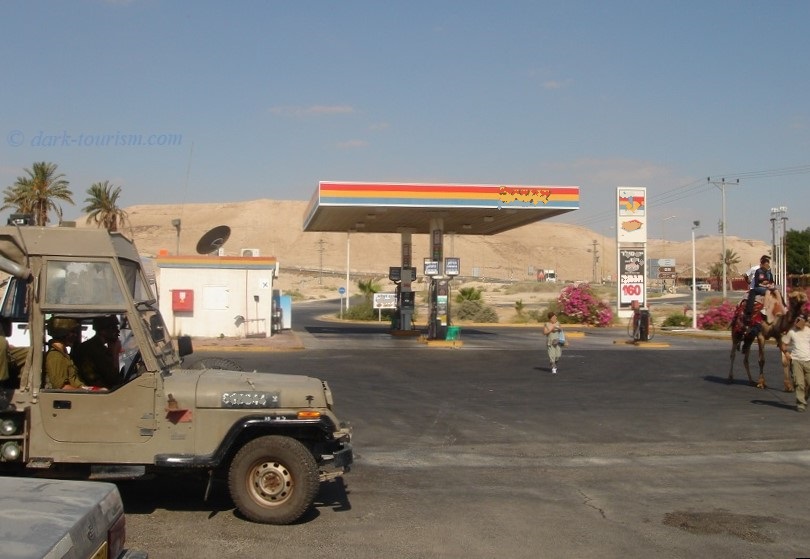
Funnily enough, though, at that same petrol station there was also a guy with a camel and you could pay to go on a short camel ride. A couple out of our group did that – seen just on the right edge of the photo.
We then drove on to Masada in the Judaean Desert (or is it the Desert of Judea? 😉 ). Here’s an image of a desert canyon taken from the cable car to the top of Masada:
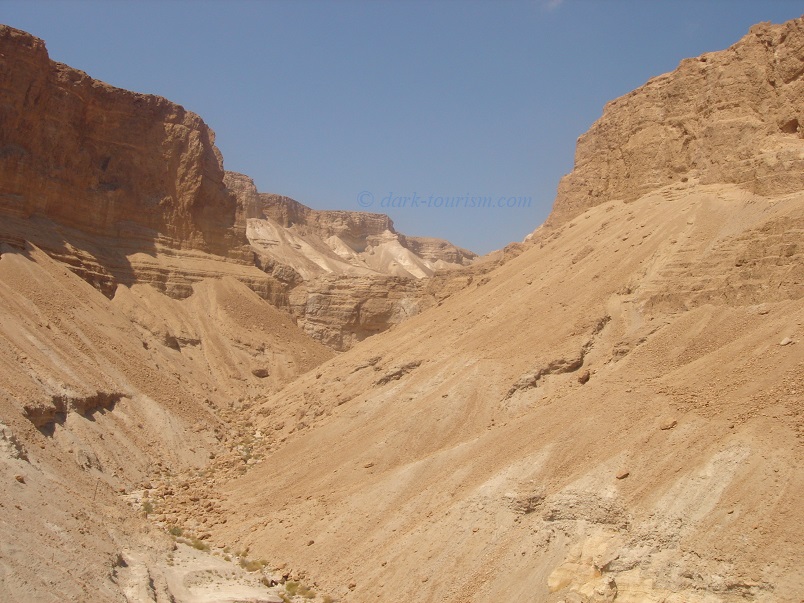
Masada itself is an ancient place and one of great importance to Jews as a site of martyrdom. This took place in the days of the Roman Empire when Roman troops laid the fortress at the top of the rocky plateau of Masada under siege – and this ended with the mass suicide of nearly a thousand Jewish rebels against Roman domination, who chose death over capture and enslavement by the Romans. That tragic chapter in history was so long ago that it would normally not qualify for the concept of dark tourism as it is understood by this author (namely as a concept situated in modernity – following the Lennon/Foley school of thought), but Masada is still very much worthy of a visit (and it is indeed one of the most popular destinations within Israel, not just, but especially for Jewish tourists).
Here’s a photo from up there – and you get a view of the Dead Sea in the background:
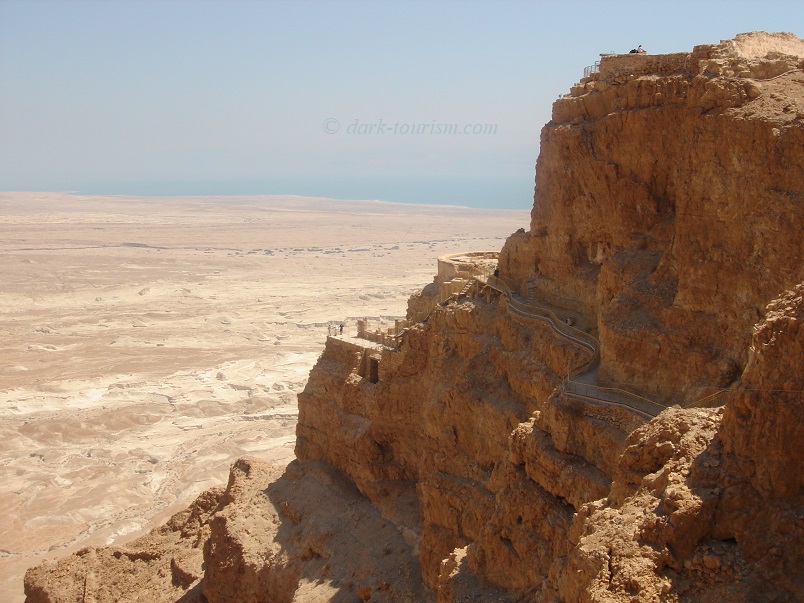
The Dead Sea can certainly be seen as a DT destination because it represents an environmental disaster: it has been drying out for many decades due to too much water being taken for irrigation (by both Israel and Jordan) from the Dead Sea’s sole freshwater contributory, the Jordan River. The Dead Sea, which is actually a lake, has hence also become even saltier and hence “deader” than it had already been (the sole aquatic life in it could only be found where the river flows into the lake at its northern end). The shores of the once much larger Dead Sea have been receding for a long time. In this next photo you can see some of the dried-up land left behind by the vanished water:
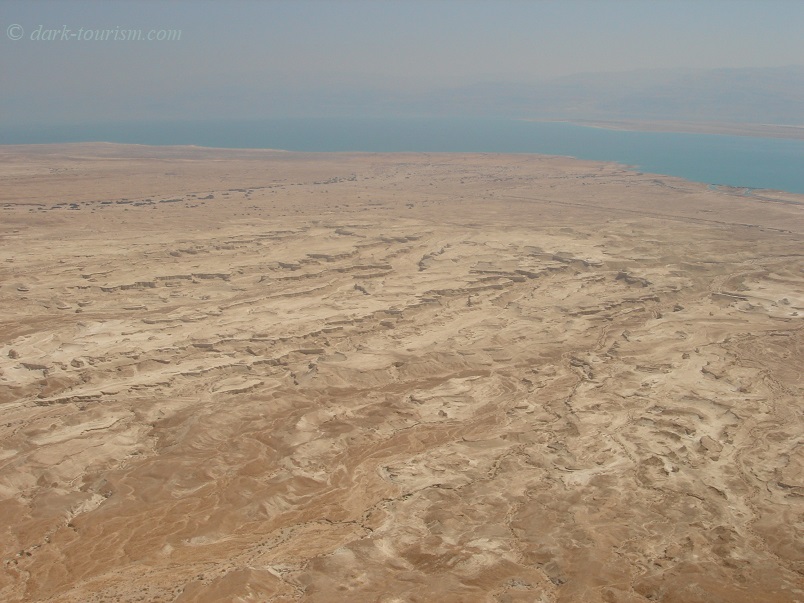
Many people are keen to go bathing in the Dead Sea, but in order to do so you have to travel far from the former shoreline. When I was there, there was a shuttle bus taking visitors the extra mile or so from the main road to the water (now it will be much further still), where there were just a few improvised facilities:
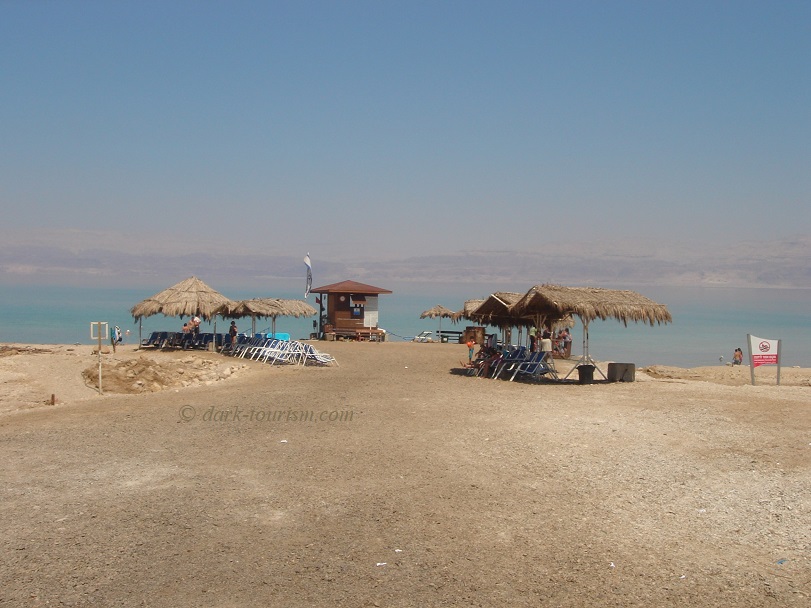
The Dead Sea is famous for its outstanding buoyancy, which is due to its extreme salinity. You can just float like a cork bobbing on the water’s surface without having to do anything. You just sit down in the water, lean back and lie on its surface and float. You can’t go under. It’s briny waters are also supposed to be good for the skin – but if you have just the tiniest of scratches these will hurt like hell when they come into contact with the salty water. In fact, the water is so full of salts and other chemicals that it is dangerous, and you are not allowed to actually swim in it for fear you might accidentally get a gulp of this toxic brine in your mouth. There are in fact warning signs to this effect by the shore, such as this:
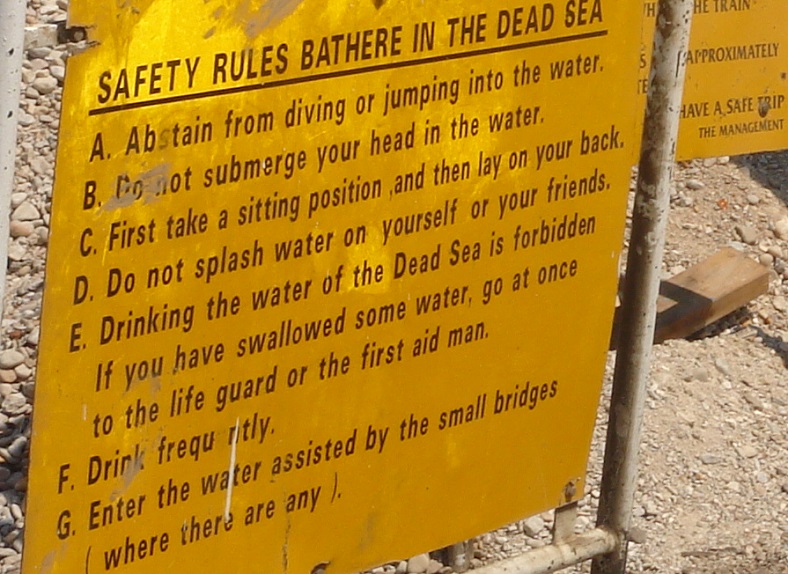
And you can also see how salty the water must be, going by the salt crusts it leaves on rocks and dead plants by the shoreline, as seen in this photo:
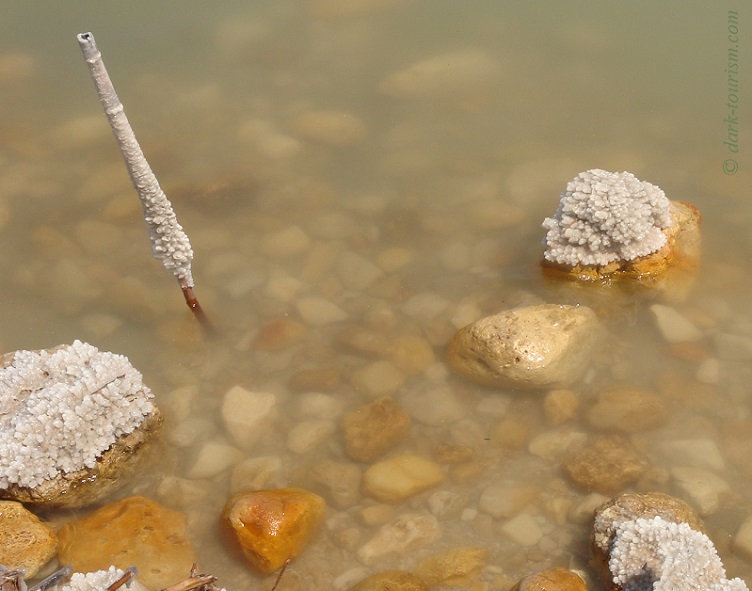
The other excursion we undertook from Tel Aviv was a day trip to Jerusalem. This was highly interesting for various reasons. For one thing there is of course all that ancient history, Jewish, Christian and Muslim (plus Roman). For all three of the main monotheistic religions this is one of the holiest places there is. And the layers of history have literally piled up. The oldest parts are now often many metres below the current street level. To get into some of the oldest churches you have to descend stairs. In contrast to that, the third-holiest site in Islam, the Al-Aqsa Mosque, sits atop a hill that for the Jews is Temple Mount. These names alone indicate friction even if you don’t know the ins and outs of all that religious significance …
Here’s a photo with a view over Jerusalem’s Old Town – the golden dome is that of the Al-Aqsa Mosque:
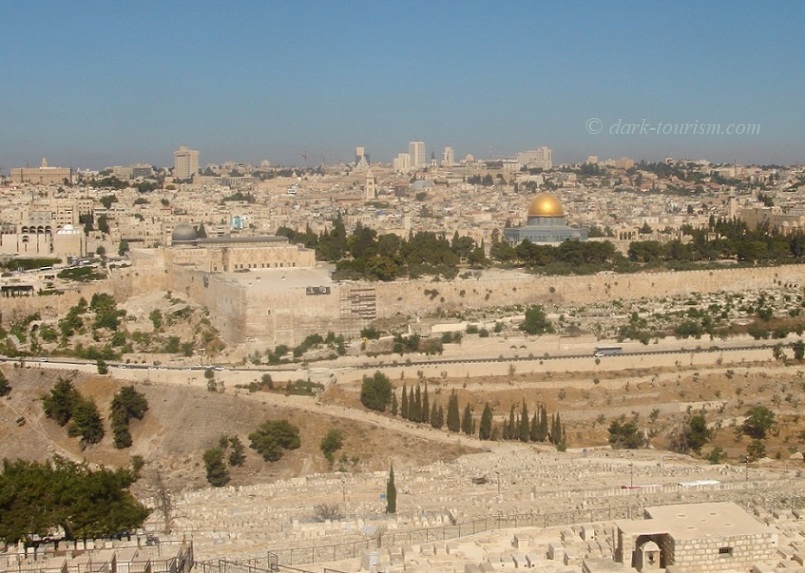
From a vantage point not far from here you could also see into parts of Jerusalem where Israel has constructed a high so-called “Separation Wall” between the territory it claims (and has settled) and the Palestinian side:
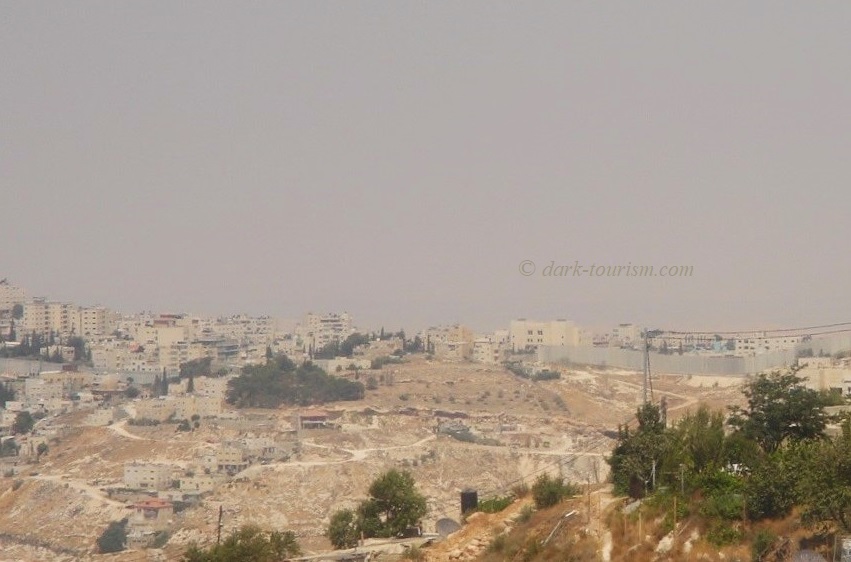
Of course we also went into the Old Town itself. Amongst other things we visited the famous “Wailing Wall”, aka “Western Wall” to Jews, as it is a remnant of the old original walls of Temple Mount. There is also a separation fence at the bottom of the wall at a right angle … this time to keep women and men apart and in their respective own sections for prayer (just like is customary in a synagogue as well):
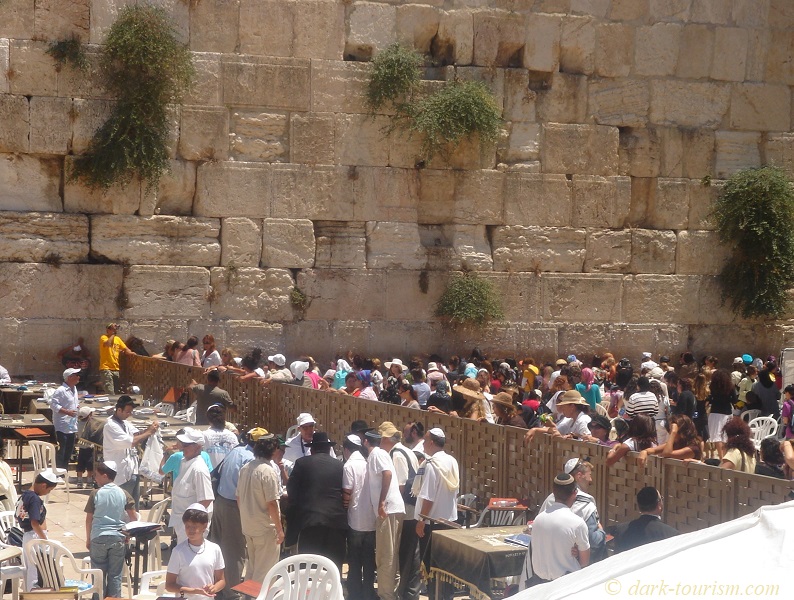
I know about the religious rooting of this separation, but I still found it somewhat ironic in this context of modern conflict …
By the way, when we chatted to the former BBC journalist in our group (see above) and quizzed him about his outlook for the Middle East conflict, he at one point said that even if Israel somehow managed to solve its issues with Palestine, it would simply continue in-fighting, i.e. between the strict Orthodox Jews in Jerusalem and the more secular parts of the Israeli people as you find more of in Tel Aviv (some of whom apparently make a point of having sex on the Sabbath and indulging in eating pork sausages).
We were also guided through parts of Jerusalem’s Old Town’s warren of narrow alleyways, as depicted in this next photo:
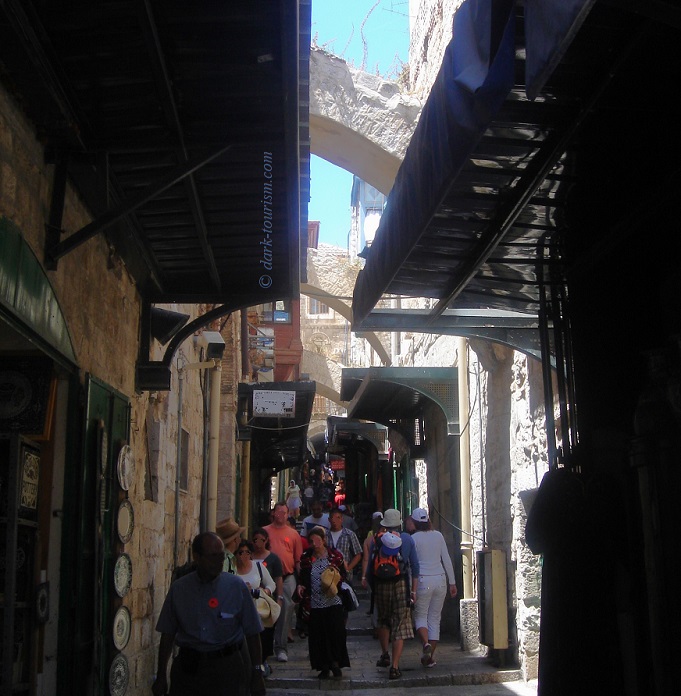
We were not allowed, however, to go as far as the top of the Via Dolorosa (the route Jesus took towards his crucifixion site), as that was close to the Al-Aqsa Mosque and hence temporarily off limits to visiting tourists for security reasons.
The tenseness of the atmosphere was brought home to me by a little incident I witnessed and that’s burned into my memory: as we were proceeding down one of the narrow alleyways past a police station, the only real sign of which was a small intercom box on the wall, I observed a teenage Palestinian boy walking in the opposite direction to us casually giving the intercom box a quick whack with his elbow as he walked past … without doing any damage, but still you could sense the air of aggression hanging in the air …
Part of the tour was also a (far too short) visit to Yad Vashem, Israel’s central Holocaust remembrance site. Here’s a photo of the original memorial building (the place that politicians always visit):
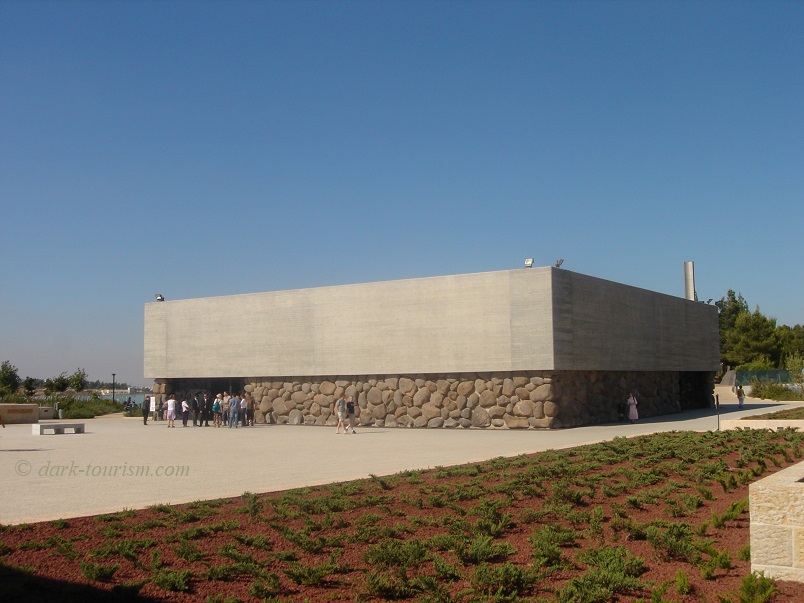
The premises around this memorial building at Yad Vashem also feature various outdoor monuments and memorials, including the Garden of the Righteous, where people declared “Righteous Among the Nations”, like e.g. Oskar Schindler or Raoul Wallenberg, are honoured for their role in helping Jews escape the Holocaust. Here’s a (not very good) photo of part of this section:
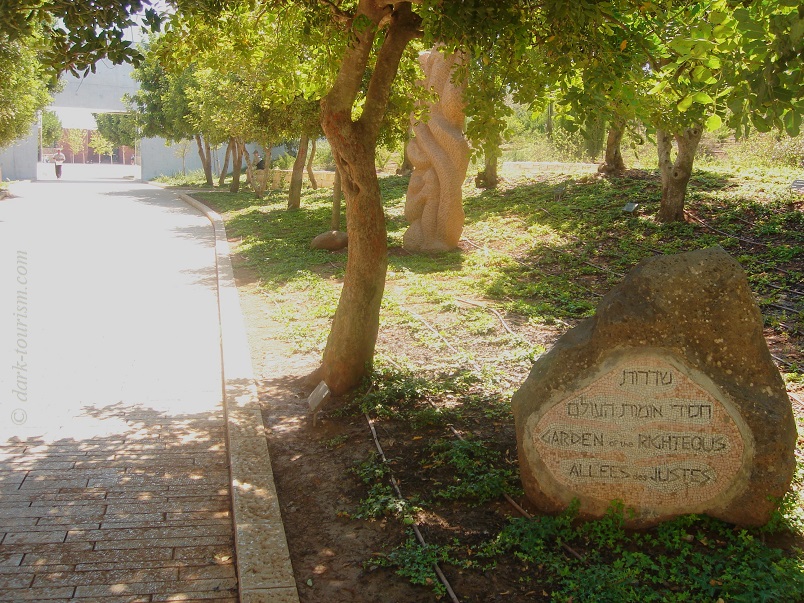
Finally here’s a photo I took at the end of the central corridor of the more modern Holocaust Museum at Yad Vashem. It ends at a kind of balcony overlooking the lands beyond Jerusalem. When I was there a woman rolled a wheelchair close to the edge for the occupant to have a good view, which resulted in this rather atmospheric composition (same image as the one at the top of this post):
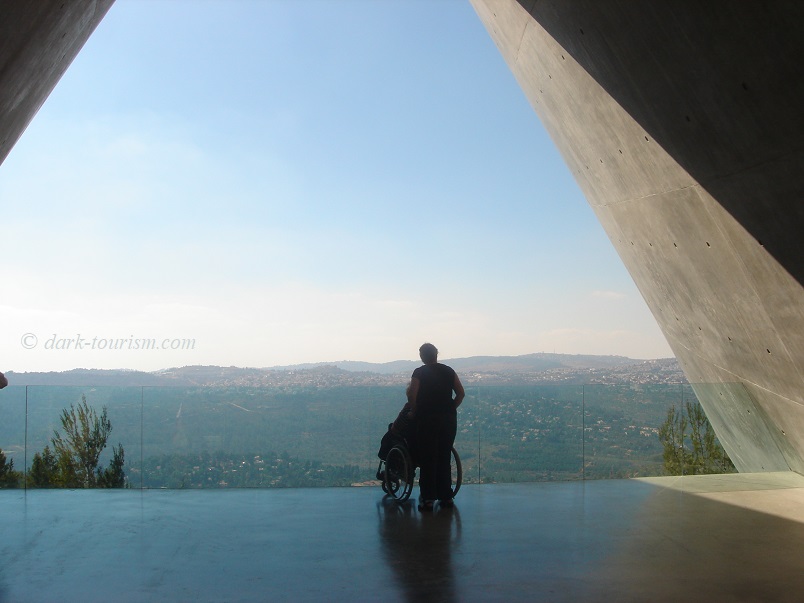
But with this I will bring the photo essay and report from my 2006 trip to Israel to a close.
I wonder whether trips like the one described here will become possible again any time soon. Right now, tourists are urged to stay away and those still in the country are advised to get out or are/have been evacuated by their governments.
I do hope, though, that places like Masada and the Dead Sea as well as Jerusalem, and in particular Yad Vashem, will become regularly accessible to tourism again, once this current storm of violence will hopefully have blown over.
And I do genuinely have hope for that – unlike for Artsakh/Nagorno-Karabakh. While the latter is probably gone for good now, and no international efforts seem to be anywhere on the horizon to try and change that, Israel has much more support in the world, not just morally but also militarily (not least from the USA). I simply cannot see Israel being wiped off the map in the way Artsakh now has, even if that is the declared goal of Hamas, Hezbollah and their big ally Iran. I just don’t think it would be allowed to happen. But what that might cost is hard to predict … in the first instance probably more violence and yet more civilian casualties (and also a distraction from the war in Ukraine in the media and possibly in politics!).
But as the saying goes, hope dies last …
.
.
.

